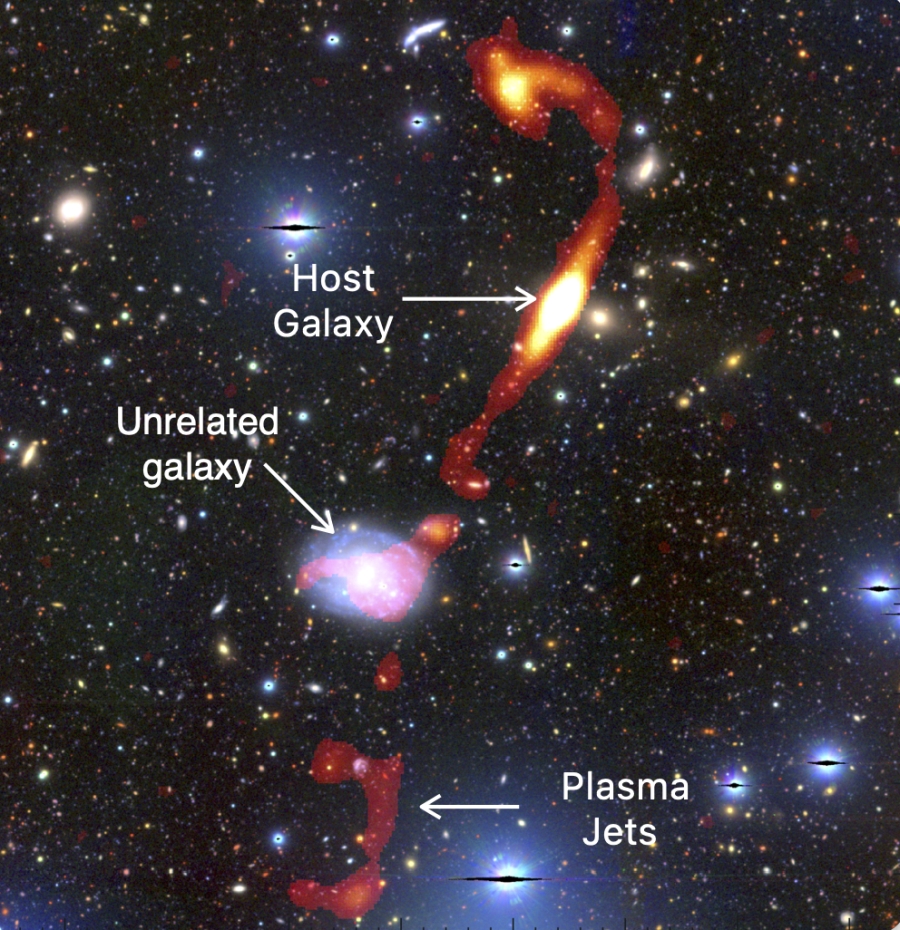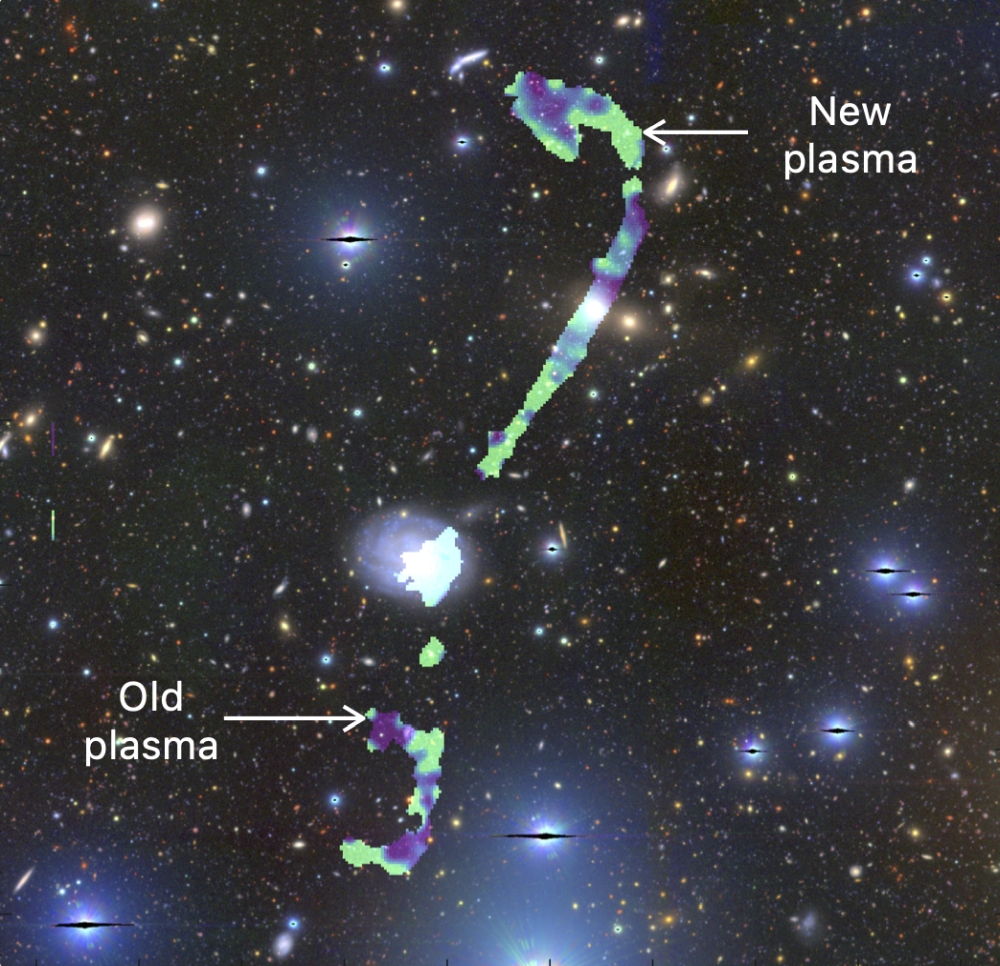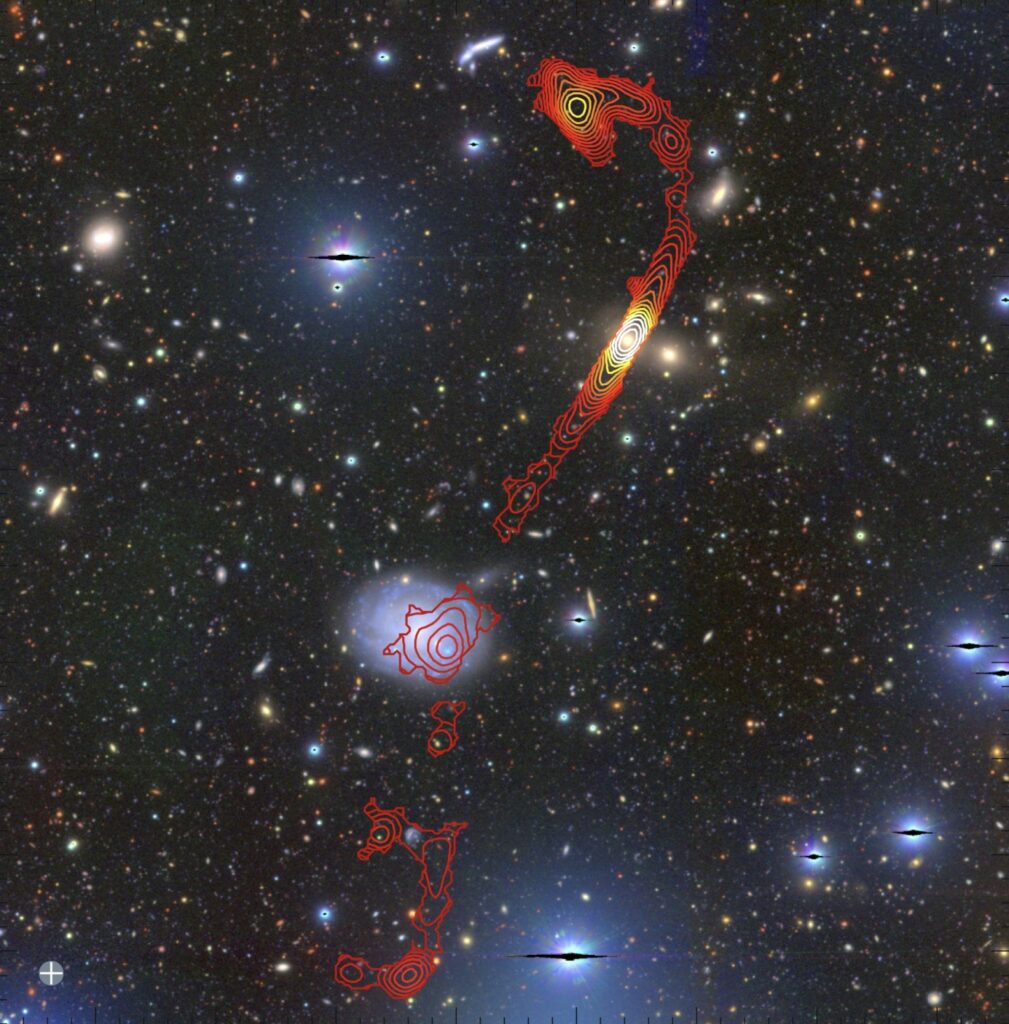With the help of IDIA facilities, South Africa’s MeerKAT telescope has uncovered an extraordinary new giant radio galaxy nicknamed ‘Inkathazo‘, meaning ‘trouble’ in the African Xhosa and Zulu languages. This discovery sheds light on the evolution of the largest structures in the Universe and offers new, yet confusing, insights into their mysterious origins.
The work has been published in the Monthly Notices of the Royal Astronomical Society.
Giant radio galaxies, or ‘GRGs’ for short, are rare cosmic behemoths spewing jets of hot plasma millions of light-years across intergalactic space. These plasma jets, which glow at radio frequencies, are powered by supermassive black holes at the centers of galaxies.
Until recently, GRGs were thought to be quite rare. However, a new generation of radio telescopes, such as South Africa’s MeerKAT radio telescope, along with the help of big data processing facilities, such as those at IDIA, have now turned this idea on its head.
“The number of GRG discoveries has absolutely exploded in the past five years thanks to powerful new telescopes like MeerKAT,” said Kathleen Charlton, an IDIA Master’s student at the University of Cape Town and the first author of the study. “Research into GRGs is developing so rapidly that it’s becoming hard to keep up. It’s incredibly exciting!”
In order to effectively process and analyse her MeerKAT data, Charlton relied on IDIA facilities such as ilifu and the Cube Analysis and Rendering Tool for Astronomy (CARTA). Charlton elaborates: “The ilifu storage and processing units allowed me to process my data in an efficient way. Before, we did not have the tools available to process spectral ages on such large scales and in such detail before.”
A Hidden Giant Revealed
Stunning MeerKAT images of ‘Inkathazo’, produced using CARTA, were revealed today in a study published in the Monthly Notices of the Royal Astronomical Society by Charlton and other members of the international ‘MIGHTEE’ team of astronomers (see paper here). The plasma jets of this cosmic giant span 3.3 million light-years from end-to-end, which is over 32 times the size of the Milky Way.

However, aspects of this GRG remain puzzling to researchers. “We nicknamed this giant galaxy ‘Inkathazo,’ meaning ‘trouble’ in isiZulu and isiXhosa because it has been a bit troublesome to understand the physics behind what’s going on here,” said Charlton.
“It doesn’t have the same characteristics as many other giant radio galaxies. For example, the plasma jets have an unusual shape. Rather than extending straight across from end-to-end, one of the jets is bent.”
Additionally, Inkathazo lives at the very centre of a cluster of galaxies, rather than in relative isolation, which should make it difficult for the plasma jets to grow to such enormous sizes.
“This is an exciting and unexpected discovery,” said Dr Kshitij Thorat, a co-author of the study from the University of Pretoria. “Finding a GRG in a cluster environment raises questions about the role of environmental interactions in the formation and evolution of these giant galaxies.”
It’s complicated!
To try and understand more about this cosmic conundrum, the researchers took advantage of CARTA and MeerKAT’s exceptional capabilities to create some of the highest-resolution spectral age maps ever made for GRGs. These maps track the age of the plasma across different parts of the GRG, providing clues about the physical processes at work.

The results revealed intriguing complexities in Inkathazo’s jets, with some electrons receiving unexpected boosts of energy. The researchers believe this may occur when the jets collide with hot gas in the voids between galaxies in a cluster.
“This discovery has given us a unique opportunity to study GRG physics in extraordinary detail,” said Thorat. “The findings challenge existing models and suggest that we don’t yet understand much of the complicated plasma physics at play in these extreme galaxies.”
Unveiling the Southern Sky with MeerKAT and IDIA
Most known GRGs have been found at northern latitudes with European telescopes, while the southern sky remains relatively unexplored for such giant objects. Yet Inkathazo is not alone. It is in fact the third GRG to be spotted in a small patch of sky, around the size of five full moons, that astronomers refer to as ‘COSMOS’.
When the ‘MIGHTEE’ collaboration of astronomers observed COSMOS with the MeerKAT telescope, they immediately spotted the other two other GRGs and published their findings in 2021 [link]. Inkathazo was spotted more recently in follow-up observations with MeerKAT.
“The fact that we unveiled three GRGs by pointing MeerKAT at a single patch of sky goes to show that there is likely a huge treasure trove of undiscovered GRGs in the southern sky” said Dr Jacinta Delhaize, a researcher at the University of Cape Town who led the 2021 publication. “MeerKAT is incredibly powerful and in a perfect location, so is excellently poised to uncover and learn more about them.”
MeerKAT, operated by the South African Radio Astronomy Observatory (SARAO), has been pivotal in uncovering the hidden treasures of the southern sky. As a precursor to the Square Kilometre Array (SKA), MeerKAT offers unprecedented sensitivity and resolution. Combined with the essential processing and visualisation abilities of IDIA’s facilities, this has enabled exciting discoveries like Inkathazo.
“This discovery would not have been possible without the use of the IDIA facilities. Being able to visualise Inkathazo in CARTA enabled me to confirm it as a GRG.” says Charlton. Dr Delhaize goes on to elaborate: “We’re entering an exciting era of radio astronomy. While MeerKAT has taken us further than ever before, the SKA will allow us to push these boundaries even further and hopefully solve some of the mysteries surrounding enigmatic objects like giant radio galaxies.”
Access the Study
The study, titled “A spatially-resolved spectral analysis of giant radio galaxies with MeerKAT,” is published today, 20th January 2025, in the Monthly Notices of the Royal Astronomical Society with open access.
Additional Media

Credit: K.K.L Charlton (UCT), MeerKAT, HSC, CARTA, IDIA.
Related Links
- For more information, see the latest episode of The Cosmic Savannah Podcast “Episode 77: Troublesome ‘Inkathazo’ and the Age of Giants” where authors Kathleen Charlton and Jacinta Delhaize discuss the research in more detail.
- For information on the original discovery of giant radio galaxies in COSMOS, see the press release and associated publication Delhaize et al., (2021) in MNRAS
Contacts
Please find contact information below for media enquiries.
Lead-author:
Ms Kathleen Charlton (MSc student, University of Cape Town).
Email: CHRKAT009@myuct.ac.za
Most of the research was conducted as part of Kathleen’s Bachelor of Science Honours research project at UCT.
Supervisors (co-authors):
Dr Jacinta Delhaize (Lecturer, University of Cape Town)
Email: drjdelhaize@gmail.com
A/Prof Kshitij Thorat (Associate Professor, University of Pretoria)Email:
kshitijthorat.astro@gmail.com
MIGHTEE collaboration:
This work was co-authored by several members of the international MIGHTEE collaboration of astronomers, led by Prof Matt Jarvis (University of Oxford) and with key contributions by Dr Ian Heywood (University of Oxford). The MeerKAT International Gigahertz Tiered Extragalactic Exploration (MIGHTEE) survey is a Large Survey Project being conducted with the MeerKAT telescope. Its overarching goal is to study the formation and evolution of galaxies. For more info see https://www.mighteesurvey.org/
Contact: Prof Matt Jarvis matt.jarvis@physics.ox.ac.uk
